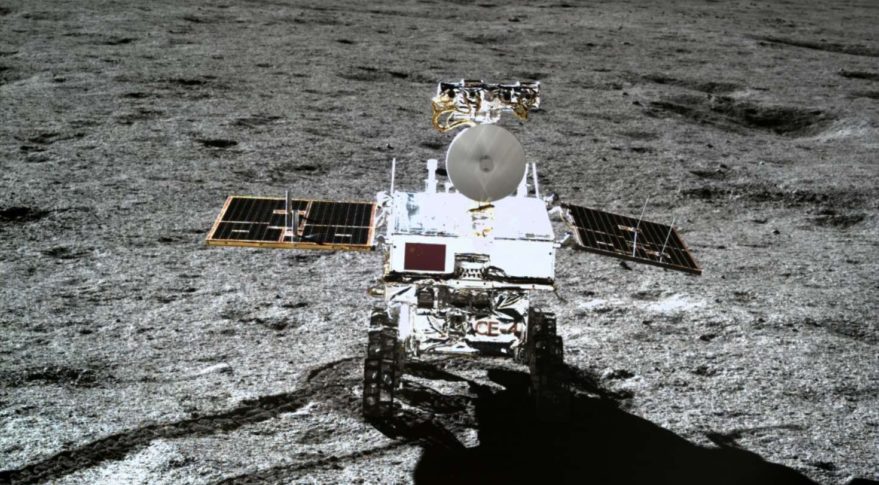What Lies Below the Moon's Crust? China's Yutu-2 Rover May Be the First to Find Out.
It may have discovered a sample of the moon's rocky mantle.

The first rover on the far side of the moon may have discovered the first samples from the moon's mantle, released from the lunar interior by a giant, ancient cosmic impact, a new study finds.
These findings suggest the rover, China's Yutu-2, may one day help solve the mystery of how the moon formed and evolved.
Previous research suggested that like the solar system's other inner rocky bodies, the moon was covered with an ocean of magma up to hundreds of miles deep when it was newly formed and still hot from its creation. As this magma ocean cooled and solidified, denser minerals rich in iron and magnesium, such as olivine, would have crystallized at its base, while lighter minerals rich in silicon and aluminum, such as plagioclase, would have floated to the surface, potentially explaining why large portions of the moon's crust are now 98 percent plagioclase.
Related: China On the Moon! A History of Chinese Lunar Missions in Pictures
However, this prevailing model of the moon's formation and evolution is hotly debated. This is because it remains uncertain whether the lunar magma ocean had the right mix of chemical and physical features for its minerals to separate as the model suggests they did.
One way to help solve the mystery of the moon's earliest days is to analyze its mantle — the rocky region under the moon's crust but above its core — about which much remains unknown. NASA's Apollo missions and the Soviet Union's Luna probes, which each landed on the near side of the moon, all failed to return samples of the lunar mantle. (The way that Earth and the moon rotate leads Earth to see only one face of the moon, dubbed its near side.)
Instead of launching probes to drill into the moon to retrieve lunar mantle samples, scientists have long suggested letting cosmic impacts on the moon do the dirty work of digging, the study's researchers said. For example, on the far side of the moon, a giant, ancient collision excavated a 1,550-mile (2,500-kilometer) crater known as the South Pole-Aitken Basin.
Get the Space.com Newsletter
Breaking space news, the latest updates on rocket launches, skywatching events and more!
"Very large impact craters — for example, the South Pole-Aitken Basin — can potentially penetrate through the crust and sample the lunar mantle," study co-author Bin Liu, a planetary scientist at the Key Laboratory of Lunar and Deep Space Exploration in Beijing, told Space.com.
Now, using the Yutu-2 rover, Chinese scientists have revealed what may be the first details of the lunar mantle.
In January, the Chang'e 4 lander deployed Yutu-2 on the relatively smooth floor of 115-mile-wide (186 km) Von Kármán crater within the South Pole-Aitken Basin. The rover discovered minerals that appeared markedly different from typical lunar surface material, which the researchers suggested were likely excavated from below the South Pole-Aitken Basin floor by the impact that created the nearby 45-mile-wide (72 km) Finsen crater.
Analysis of the wavelengths of light reflected off these minerals revealed the presence of olivine and low-calcium pyroxene. This matches long-standing predictions regarding the composition of the upper lunar mantle, and may support the prevailing model of lunar formation and evolution with a cooling magma ocean, the scientists noted.
"The ultimate goal is to decipher the mystery of the lunar mantle composition," Liu said.
The scientists detailed their findings in the May 16 issue of the journal Nature.
- Moonquakes Rattle the Moon as It Shrinks Like a Raisin
- Full Moon Calendar: When to See the Next Full Moon
- Moon Facts: Fun Information About the Earth's Moon
Follow Charles Q. Choi on Twitter @cqchoi. Follow us on Twitter @Spacedotcom and on Facebook.
Join our Space Forums to keep talking space on the latest missions, night sky and more! And if you have a news tip, correction or comment, let us know at: community@space.com.

Charles Q. Choi is a contributing writer for Space.com and Live Science. He covers all things human origins and astronomy as well as physics, animals and general science topics. Charles has a Master of Arts degree from the University of Missouri-Columbia, School of Journalism and a Bachelor of Arts degree from the University of South Florida. Charles has visited every continent on Earth, drinking rancid yak butter tea in Lhasa, snorkeling with sea lions in the Galapagos and even climbing an iceberg in Antarctica. Visit him at http://www.sciwriter.us








